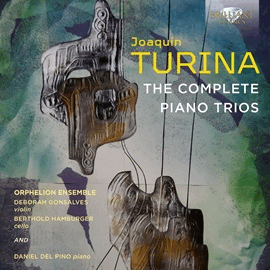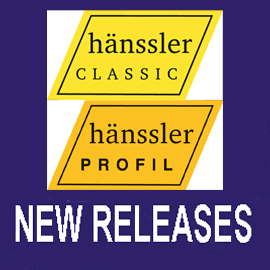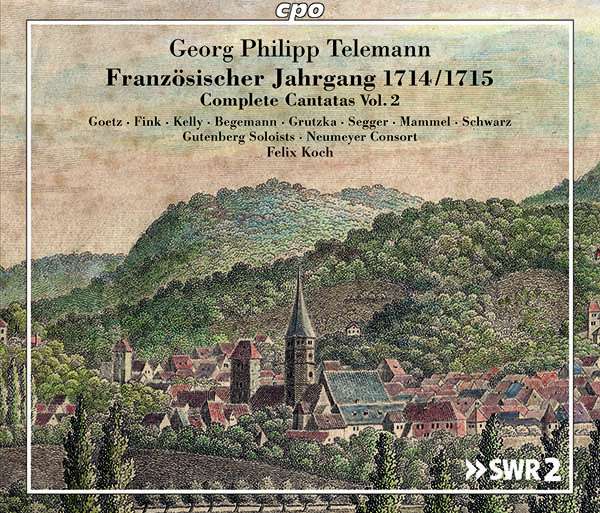Seit 2021 präsentiert cpo jährlich eine Folge des ehrgeizigen Projekts, einen kompletten Jahrgang Telemannscher Kantaten einzuspielen: Hierbei handelt es sich um den Französischen von 1714 und 1715. Anders als der ‘Harmonische Gottesdienst’ mit seinen kleinen Solokantaten präsentiert dieser Jahrgang durchgehend Werke für Chor, Solisten und Orchester. Dabei scheint sich Telemann immer wieder auszuprobieren, neu zu erfinden: originelle Besetzung (zum Beispiel eine Bass-Partie mit zwei Fagotten oder fulminante Chöre mit Pauke und drei Trompeten), schlichte und damit umso eindringlichere Choräle, elegante Arien, flutende Chorfugen und Tuttipassagen mit anspruchsvollen Rhythmen und Koloraturen.
All das zeichnete bereits die erste Doppel-CD aus, die im November 2021 erschien. Musste man für diese im ersten Coronajahr produzierte Aufnahme aber noch mit variierenden Aufstellungen arbeiten, ist Vol. 2 (ebenfalls beim Projektpartner SWR in Kaiserslautern eingespielt) nun auch raumklangtechnisch aus einem Guss. Homogen und durchhörbar entdeckt man erneut Kantate für Kantate den Kosmos von Telemanns Vokalschaffen, staunt über diese Kreativität, die genaue Übersetzung der Sprache in Musik und die exakte Umsetzung durch die Interpreten. Der Schwung des zu Entdeckenden, der Vol. 1 innewohnt, hat sich in einen immer noch neugierigen, aber eben auch zunehmend routinierten Umgang mit Telemanns Musik gewandelt: Alle Mitwirkenden haben sich in diese faszinierende Tonsprache noch intensiver hineingehört und -musiziert.
Felix Koch ist der künstlerische Leiter des als Telemann Project firmierenden Vorhabens. Und man merkt: Er liebt diesen Komponisten. Was man genauso hört: Koch ist imstande, diese Begeisterung ohne Reibungsverluste auf sein wendiges und transparent (historisch informiert) musizierendes Neumeyer Consort sowie die jungen Sängerinnen und Sänger der mit nur zwölf Stimmen besetzten Gutenberg Soloists zu übertragen. Alles ist durchhörbar und ausgewogen. Wie seinerzeit üblich sind die Solostimmen dabei Teil des Chores und fügen sich hier bemerkenswert verschmelzend in den makellosen Gesamtklang ein.
Das Telemann Project lädt für jede CD mindestens einen namhaften Künstler ein und vergibt die anderen Solopartien an die kommende Generation. Sabine Goetz und Julie Grutzka (Sopran), Lieselotte Fink und Luca Segger (Alt/Altus), Hans Jörg Mammel und Fabian Kelly (Tenor) sowie Hans Christoph Begemann und Gotthold Schwarz (Bass) sind die Solisten dieser CDs und überzeugen sämtlich gleich auf zweierlei Weise: Zum einen besitzen sie die Fähigkeit, sich gänzlich in den Dienst dieser Musik und somit jede persönliche Profilierung zurück zu stellen; zum anderen gefallen alle durch stimmlichen Wohlklang, dem man einfach gerne zuhört. Telemann schrieb eher instrumental und hat offenbar nicht immer daran gedacht, dass seine Sänger die Partien auch problemlos sollten bewältigen können. Die Künstler dieser Aufnahme nehmen die Herausforderung jedoch mit delikatem Erfolg an. Zudem darf man dank der Doppelbesetzung jedes Registers gerne vergleichen, möchte jedoch kaum einen Favoriten ausmachen.
Eine Kantate sei herausgegriffen: ‘Jesus Christus, unser Heiland’ (TVWV 1:976 zum dritten Ostersonntag nach Trinitatis), denn hier besticht schon allein die auffällige Zahlensymbolik. Der Chor singt vom Sterben und tatsächlich scheint das Orchester sein Leben bald auszuhauchen. Dann folgen drei dumpfe Akkorde – die Tage, die Christus im Grab lag – und der Chor erwacht buchstäblich zum Leben, wobei die folgende Triolenseligkeit (mit rhythmisch vertrackter Verschränkung) wiederum für die Zahl 3 steht. Schließlich intoniert Hans Christoph Begemann eine chorbegleitete Arie, die von der Grabesruhe der müden Seele erzählt und nicht zufällig werden sofort Erinnerungen an den Schlusschoral aus Bachs Johannespassion wach: Auch – und vor allem! – hier geht schlicht der Himmel auf, wenn die vier Chorstimmen über dem kernigen Bariton Begemanns wie von ferne süßen Frieden und im Grabe blühende Rosen besingen. Allein für dieses Stück hat sich der Kauf dieser CDs mit neun Kantaten gelohnt.
Since 2021, cpo has presented an annual installment of the ambitious project to record a complete vintage of Telemann cantatas: This is the French cycle of 1714 and 1715. Unlike the ‘Harmonische Gottesdienst’ with its small solo cantatas, this volume presents works for choir, soloists and orchestra throughout. Telemann always seems to be trying things out, reinventing himself: original instrumentation (for example, a bass part with two bassoons or fulminant choruses with timpani and three trumpets), simple and thus all the more forceful chorales, elegant arias, flowing choral fugues and tutti passages with demanding rhythms and coloratura.
All this already characterized the first double CD, which was released in November 2021. For this recording, produced in the first year of Corona, it was necessary to work with varying setups, but Vol. 2 (also recorded by the project partner SWR in Kaiserslautern) is now a unified whole in terms of spatial sound. Homogeneous and audible, one again discovers cantata by cantata the cosmos of Telemann’s vocal work, marvels at this creativity, the exact translation of the language into music and the precise realization by the performers. The momentum of discovery inherent in Vol. 1 has turned into a still curious, but also increasingly experienced approach to Telemann’s music: All participants have listened to and played this fascinating tonal language even more intensively.
Felix Koch is the artistic director of the Telemann Project. And you can tell: he loves this composer. And you can also hear that Koch is able to transfer this enthusiasm to his agile and transparent (historically informed) Neumeyer Consort, as well as to the young singers of the Gutenberg Soloists, who have only twelve voices. Everything is audible and balanced. As was customary at the time, the solo voices are part of the choir and blend remarkably well into the flawless overall sound.
The Telemann Project invites at least one renowned artist for each CD and assigns the other solo parts to the next generation. Sabine Goetz and Julie Grutzka (soprano), Lieselotte Fink and Luca Segger (alto/altus), Hans Jörg Mammel and Fabian Kelly (tenor) as well as Hans Christoph Begemann and Gotthold Schwarz (bass) are the soloists on these CDs and all of them are convincing in two ways: On the one hand, they have the ability to put themselves entirely at the service of this music and thus to put aside any personal profiling; on the other hand, all of them please with their vocal euphony, which one simply enjoys listening to. Telemann wrote more instrumentally and obviously did not always think that his singers should be able to handle the parts without any problems. The artists of this recording, however, accept the challenge with delicate success. Moreover, thanks to the double instrumentation of each register, one may gladly compare, but would hardly want to identify a favorite.
One cantata should be singled out: ‘Jesus Christus, unser Heiland’ (TVWV 1:976 for the third Easter Sunday after Trinity), for here the striking number symbolism alone is captivating. The chorus sings of dying, and indeed the orchestra soon seems to breathe its last. Then follow three muffled chords – the days Christ lay in the tomb – and the chorus literally comes to life, with the ensuing trio bliss (with rhythmically tricky intertwining) again representing the number 3. Finally, Hans Christoph Begemann intones a chorus-accompanied aria that tells of the weary soul’s rest in the grave, and it is no coincidence that memories of the final chorale from Bach’s St. John Passion are immediately evoked: here, too – and above all! – Here, too – and above all! – heaven simply rises when the four choral voices sing of sweet peace and roses blooming in the grave over Begemann’s robust baritone, as if from afar. For this piece alone, the purchase of these CDs with nine cantatas was worthwhile.


















